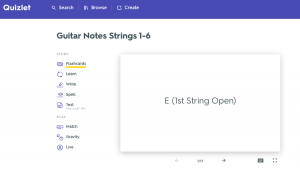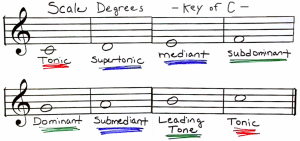School or Rock – Day 3 – Melody Basics
SUMMARY
Today’s project was quick and a lot more engaging than previous projects. I enjoyed today’s work and learning more things about melody.
CLASSROOM
- All cultures around the world share 5 notes
- These 5 notes are part of the pentatonic scale
- The key to melodies is not how many notes you use but what you do with them
- Scales are runs of notes, in Western culture, we have 12 notes in a scale
- Intervals are the space between notes
- A semitone is a space between each note
- A whole tone is a space between two notes
- Jumping from whole notes are popular because they’re easy to sing, but jumping 3, 4, 5, 6, 7, or 8 semitones are also very popular
LAB
This was a very simple project. Most of the information in the video I already knew, but I did learn some more about how Hookpad works.
PRACTICE ROOM

This project like the one previous was also very easy and simple. I already know the basics of playing guitar.
OUTSIDE / JOURNAL / IDEAS
Things I found interesting about this video:
- She says that creative minds are viewed to be linked with suffering but that’s an idea we should throw away.
- In ancient Greece and Rome thought that there was a disembodied creature that helped them with creativity
- eventually, we started to believe that creativity comes from the human and that humans were the center of the universe and she thinks that pressure on an artist can lead them down a dark path
- She believes that creativity more of came to us instead of us being the center of creativity.
- Relieving anxiety by making it less of you feeling the pressure of creating and letting it come to you can help with feeling better about the process of creating
STUDIO
- By Jamie Henke, music.wisc.edu/faculty/jamie-henke/
Melody Composition Terms
- Theme – a long, flowing melodic idea
- Motive – A short, rhythmic idea
- Period – 8 measure musical sentence
- Phrase – 4 measure sub-period
- Antecedent (Question) Phrase – First 4 measures of a period
- Consequent (Answer) Phrase – Second 4 measures of a period
- Scale Degrees
- Tonic – is the start and stop note/home
- Supertonic, Mediant, Submediant – lower level of tension/the weird aunt’s house
- Dominant, Subdominant, Leading Tone – moving notes/rise tension/away from
- Steps – a hole note
- Leaps – anything up to more than a hole note
- Conjunct motion – melody built primarily of steps
- Disjunct motion – melody built primarily of leaps
- Repetition – Repeated material (i.e. motive) used to create a link between two phrases of the period
- Contrast – Two phrases that contain contrasting material to create tension and interest
- Variation – Halfway between contrast and repetition. The two phrases include some recognizable material and some varied material (i.e. taking ideas up an octave
Melody Resources


Mr. Le Duc’s Key of C Major Notes and Chords Chart (PDF)
CONTROL ROOM
Learn how to Create Tracks
Explore the Piano Roll, Drawing and Moving Notes
Learn to Edit Notes, Velocity, and More
Learn to Create Your Own Presets
- I mainly messed around with notes in the key of C. I didn’t create something that would get a Grammy for but I did make a half-decent melody to build off of.
WHAT I LEARNED and PROBLEMS I SOLVED
I actually learned a lot today. I found that TED talk to be quite interesting. most of the videos though I have already seen so it was a good refresher. One thing I problem solves was the time it takes to watch some of these videos. I found it much more helpful for myself to cut the video time in half by speeding it up and pausing it when I need a second to write something down. This little tool cut my average work time from 3 hours to a hour and a half.
Be First to Comment